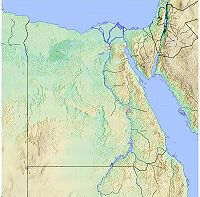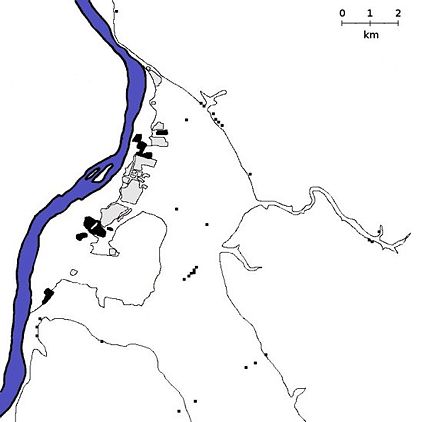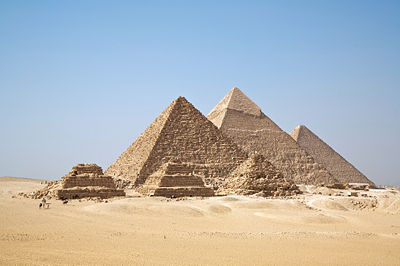Amarna

The site of Amarna (commonly known as el-Amarna or incorrectly as Tel el-Amarna; see below) (Arabic: العمارنة al-‘amārnah) is located on the east bank of the Nile River in the modern Egyptian province of Minya, some 58 km (38 miles) south of the city of al-Minya, 312 km (194 miles) south of the Egyptian capital Cairo and 402 km (250 miles) north of Luxor.[1] The site of Amarna includes several modern villages, chief of which are el-Till in the north and el-Hagg Qandil in the south.
The area contains an extensive Egyptian archaeological site that represents the remains of the capital city newly–established and built by the Pharaoh Akhenaten of the late Eighteenth Dynasty (c. 1353 BC), and abandoned shortly afterwards.[2] The name for the city employed by the ancient Egyptians is written as Akhetaten (or Akhetaton – transliterations vary) in English transliteration. Akhetaten means "Horizon of the Aten."[3]
The area was also occupied during later Roman and early Christian times, excavations to the south of the city have found several structures from this period.[4]

Contents |
Naming issues
The frequent designation "Tel el-Amarna" for the city is inaccurate: nowhere do the ancient remains constitute a mound of eroded architecture that would warrant the description of a "Tell" (Arabic: "hill"), so common elsewhere in the region. Cyril Aldred notes that the name "Tel el-Amarna" is a misunderstanding of the name for one of the modern villages near the ruins, Et Til el Amarna. The name "Amarna" itself comes from the name of a tribe of nomads, the Beni Amran, who left the Western Desert in the 8th century to settle on the banks of the Nile along this stretch.
The city of Akhetaten

The area of the city was effectively a virgin–site, and it was in this city that the Akhetaten described as the Aten's
"..the seat of the First Occasion, which he had made for himself that he might rest in it."
It may be that the Royal Wadi's resemblance to the hieroglyph for horizon showed that this was the place to found the city.
The city was built as the new capital of the Pharaoh Akhenaten, dedicated to his new religion of worship to the Aten. Construction started in or around Year 5 of his reign (1346 BC) and was probably completed by Year 9 (1341 BC), although it became the capital city two years earlier. To speed up construction of the city most of the buildings were constructed out of mud-brick, and white washed. The most important buildings were faced with local stone.[5]
It is the only ancient Egyptian city which preserves great details of its internal plan, in large part because the city was abandoned after the death of Akhenaten. The city seems to have remained active for a decade or so after his death, and a shrine to Horemheb indicates that it was at least partially occupied at the beginning of his reign,[6] if only as a source for building material elsewhere. Once it was abandoned it remained uninhabited until Roman settlement[4] began along the edge of the Nile. However, due to the unique circumstances of its creation and abandonment, it is questionable how representative of ancient Egyptian cities it actually is. Akhetaten was hastily constructed and covered an area of approximately 8 miles of territory on the east bank of the Nile River; on the west bank, land was set aside to provide crops for the city's population.[3] The entire city was encircled with a total of 14 boundary stelae detailing Akhenaten's conditions for the establishment of this new capital city of Egypt.[3]
The earliest dated stelae from Akhenaten's new city is known to be Boundary stelae K which is dated to Year 5, IV Peret (or month 8), day 13 of Akhenaten's reign.[7] (most of the original 14 boundary stelas have been badly eroded). It preserves an account of Akhenaten's foundation of this city. The document records the pharaoh's wish to have several temples of the Aten to be erected here, for several royal tombs to be created in the eastern hills of Akhetaten for himself, his chief wife Nefertiti and his eldest daughter Meritaten as well as his explicit command that when he was dead, he would be brought back to Akhetaten for burial.[8] Boundary stela K introduces a description of the events that were being celebrated at Akhetaten:
| “ | His Majesty mounted a great chariot of electrum, like the Aten when He rises on the horizon and fills the land with His love, and took a goodly road to Akhetaten, the place of origin, which [the Aten] had created for Himself that he might be happy therein. It was His son Wa'enre (ie. Akhenaten) who founded it for Him as His monument when His Father commanded him to make it. Heaven was joyful, the earth was glad every heart was filled with delight when they beheld him.[9] | ” |
This text then goes on to state that Akhenaten made a great oblation to the god Aten "and this is the theme [of the occasion] which is illustrated in the lunettes of the stelae where he stands with his queen and eldest daughter before an altar heaped with offerings under the Aten, while it shines upon him rejuvenating his body with its rays."[9]
Site and plan
Located on the east bank of the Nile, the ruins of the city are laid out roughly north to south along a 'Royal Road', now referred to as 'Sikhet es-Sultan'.[10][11] The Royal residences are generally to the north, in what is known as the North City, with a central administration and religious area and the south of the city is made up of residential suburbs.
North City
Located within the North City area is the Northern Palace, the main residence of the Royal Family. Between this and the central city, the Northern Suburb was initially a prosperous area with large houses, but the house size decreased and became poorer the further from the road they were.[11]
Central City
Most of the important ceremonial and administrative buildings were located in the central city. Here the Great Temple of the Aten and the Small Aten Temple were used for religious functions and between these the Great Royal Palace and Royal Residence were the ceremonial residence of the King and Royal Family, and were linked by a bridge or ramp.[12] Located behind the Royal Residence was the Bureau of Correspondence of Pharaoh, where the Amarna Leters were found.[13]
This area was probably the first area to be completed, and had at least 2 phases of construction.[10]
Southern suburbs
To the south of the city was the area now referred to as the Southern Suburbs. It contained the estates of many of the city's powerful nobles, including Nahkt (Chief Minister), Renefer (General), Panehsy (High Priest of the Aten) and Ramose (Master of Horses). This area also held the studio of the sculpture Thutmose, where the famous bust of Nefertiti was found in 1912.[14]
Further to the south of the city was Kom el-Nana, an enclosure, usually referred to as a sun-shade, and was probably built as a sun-temple.[15], and then the Maru-Aten, which was palace or sun-temple originally thought to have been constructed for Akhenaten's queen Kiya, but on her death her name and images were altered to those of Meritaten, his daughter.[16].
City outskirts
Surrounding the city and marking its extent, the Boundary Stelae (each a rectangle of carved rock on the cliffs on both sides of the Nile) describe the founding of the city and are a primary source of information about the city.[17]
Away from the city Akhenaten's a Royal necropolis was started in a narrow valley to the east of the city, hidden in the cliffs. Only one tomb was completed, and was used by a un-named Royal Wife, and Akhenaten's tomb was hastily used to hold his and probably Meketaten, his second daughter.[18]
In the cliffs to the north and south of the Royal Wadi, the nobles of the city constructed their Tombs.
- Workmen's villages
Amarna art-style
The Amarna art-style is unique among the Egyptian world for its more realistic depiction of its subjects, instead of the strict idealistic formalism universal in Egyptian art up until that point, as well as for depicting many informal scenes such as the royal family playing with their children. Although the worship of Aten (often referred to as the Amarna heresy) was completely suppressed, the artistic legacy had a more lasting impact. The art broke with a number of important long-established Egyptian conventions. These included intimate portrayals of affection within the royal family, and the abandonment of portraying women as lighter coloured than men. The art also has a realism that sometimes borders on caricature.
Rediscovery and excavation

The first western mention of the city was made in 1714 by Claude Sicard, a French Jesuit priest who was travelling through the Nile Valley, and described the boundary stela from Amarna. As with much of Egypt, it was visited by Napoleon's corps de savants in 1798–1799, who prepared the first detailed map of Amarna, which was subsequently published in Description de l'Égypte between 1821 and 1830.[19]
After this European exploration continued in 1824 when Sir John Gardiner Wilkinson explored and maped the city remains. The copyist Robert Hay and his surveyor G. Laver visited the locality and uncovered several of the Southern Tombs from sand drifts, recording the reliefs in 1833. The copies made by Hay and Laver languish largely unpublished in the British Library, where an ongoing project to identify their locations is underway.[20]
The Prussian expedition led by Richard Lepsius visited the site in 1843 and 1845, and recorded the visible monuments and topography of Amarna in two separate visits over a total of twelve days, using drawings and paper squeezes. The results were ultimately published in Denkmäler aus Ægypten und Æthiopien between 1849 to 1913, including an improved map of the city.[19] Despite being somewhat limited in accuracy, the engraved Denkmäler plates formed the basis for scholastic knowledge and interpretation of many of the scenes and inscriptions in the private tombs and some of the Boundary Stelae for the rest of the century. The records made by these early explorers teams are of immense importance since many of these remains were later destroyed or otherwise lost.
In 1887 a local woman digging for sebakh uncovered a cache of over 300 cuneiform tablets (now commonly known as the Amarna Letters).[21] These tablets recorded select diplomatic correspondence of the Pharaoh and were predominantly written in Akkadian, the lingua franca commonly used during the Late Bronze Age of the Ancient Near East for such communication. This discovery led to the recognition of the importance of the site, and lead to a further increase in exploration.[22]
In 1891 and 1892 Alessandro Barsanti 'discovered' and cleared the king's tomb (although it was probably known to the local population from about 1880).[23] Around the same time Sir Flinders Petrie worked for one season at Amarna, working independently of the Egypt Exploration Fund. He excavated primarily in the Central City, investigating the Great Temple of the Aten, the Great Official Palace, the King's House, the Bureau of Correspondence of Pharaoh and several private houses. Although frequently amounting to little more than a sondage, Petrie's excavations revealed additional cuneiform tablets, the remains of several glass factories, and a great quantity of discarded faience, glass and ceramic in sifting the palace rubbish heaps (including Mycenaean sherds).[22] By publishing his results and reconstructions rapidly, Petrie was able to stimulate further interest in the site's potential.
The copiest and artist Norman de Garis Davies published drawn and photographic descriptions of private tombs and boundary stelae from Amarna from 1903 to 1908. These books were republished by the EES in 2006.
In the early years of the 20th century (1907 to 1914) the Deutsche Orientgesellschaft expedition, led by Ludwig Borchardt, excavated extensively throughout the North and South suburbs of the city. The famous bust of Nefertiti, now in Berlin's Ägyptisches Museum, was discovered amongst other sculptural arteftacts in the workshop of the sculptor Thutmose. The outbreak of the First World War in August 1914 terminated the German excavations.
From 1921 to 1936 an Egypt Exploration Society expedition returned to excavation at Amarna under the direction of T.E. Peet, Sir Leonard Woolley, Henri Frankfort, Stephen Glanville[24] and John Pendlebury. The renewed investigations was focused on religious and royal structures.
During the 1960s the Egyptian Antiquities Organization (now the Egyptian Supreme Council of Antiquities) undertook a number of excavations at Amarna.
Exploration of the city continues to the present, currently under the direction of Barry Kemp (Reader in Egyptology, University of Cambridge, England) under the auspices of the Egypt Exploration Society.[6][25] In 1980 A separate expedition led by Geoffrey Martin described and copies the reliefs from the Royal Tomb, later publishing its findings together with objects thought to have come from the tomb, this work was published in 2 volumes by the EES.
In 2007, the continuing EES exploration discovered a cemetery of private individuals, close to the southern tombs of the Nobles.[26]
Notes and references
References
- ↑ "Google Maps Satellite image". Google. Retrieved on 2008-10-01.
- ↑ "The Official Website of the Amarna Project". Retrieved on 2008-10-01.
- ↑ 3.0 3.1 3.2 David (1998), p.125
- ↑ 4.0 4.1 "Middle Egypt Survey Project 2006". Amarna Project (2006). Retrieved on 2007-06-06.
- ↑ Grundon (2007), p.89
- ↑ 6.0 6.1 "Excavating Amarna". Archaeology.org (2006-09-27). Retrieved on 2007-06-06.
- ↑ Aldred (1988), p.47
- ↑ Aldred (1998), pp.47-50
- ↑ 9.0 9.1 Aldred (1998), p.48
- ↑ 10.0 10.1 Waterson (1999), p.81
- ↑ 11.0 11.1 Grundon (2007), p.92
- ↑ Waterson (1999), p.82
- ↑ Moran (1992), p.xiv
- ↑ Waterson (1999), p.138
- ↑ "Kom El-Nana". Retrieved on 2008-10-04.
- ↑ Eyma (2003), p.53
- ↑ "Boundary Stelae". Retrieved on 2007-06-09.
- ↑ "Royal Tomb". Retrieved on 2008-10-04.
- ↑ 19.0 19.1 "Mapping Amarna". Retrieved on 2008-10-01.
- ↑ "The Robert Hay Drawings in the British Library". Retrieved on 2008-10-01.
- ↑ "Wallis Budge describes the discovery of the Amarna tablets". Retrieved on 2008-10-01.
- ↑ 22.0 22.1 Grundon (2007), pp.90-91
- ↑ "Royal Tomb". The Amarna Project. Retrieved on 2008-10-01.
- ↑ Grundon(2007), p.71
- ↑ "Fieldwork- Tell El-Armana". Retrieved on 2008-10-01.
- ↑ John Hayes-Fisher. "Grim secrets of Pharaoh's city". BBC Timewatch. news.bbc.co.uk. Retrieved on 2008-10-01.
Bibliography
- Redford, Donald (1984). Akhenaten : The Heretic King. Princeton.
- David, Rosalie (1998). Handbook to Life in Ancient Egypt. Facts on File Inc..
- Moran, William L. (1992). The Amarna Letters. Baltimore: Johns Hopkins University Press. ISBN 0-8018-4251-4.
- Aldred, Cyril (1988). Akhenaten, King of Egypt. Thames & Hudson.
- Grundon, Imogen (2007). The Rash Adventurer, A Life of John Pendlebury. London: Libri.
- de Garis Davies, Norman (1903-1908). The Rock Tombs of El Amarna. Part 1-6. London: EES.
- Martin, G.T. (1974, 1989). The Royal Tomb at el-'Amarna, 2 vols. London: EES.
- Aayko Eyma ed., A Delta-Man in Yebu, Universal-Publishers. 2003
- Waterson, Barbara (1999). Amarna: Ancient Egypt's Age of Revolution.
External links
- The University of Cambridge's Amarna Project
- Amarna Art Gallery Shows just a few, but stunning, examples of the art of the Amarna period.
- M.A. Mansoor Amarna Collection
| Preceded by Thebes |
Capital of Egypt (Akhetaten) c. 1353 BC - c. 1332 BC |
Succeeded by Thebes |
|
|||||||||||||
|
|||||||
